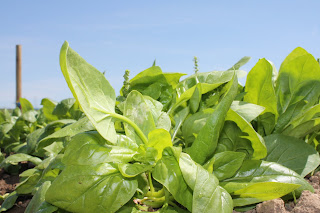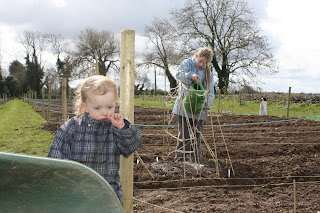
The creepy crawlies are making me lose the plot. A line of spinach is fair game to slugs, snails and rabbits but it is very annoying when these pesky pests take more than their fair share; for example my cabbage has been ripped to bits by caterpillars and gooy greenflies are smothering the broadbeans.
Should I just leave the allotment untouched and a balance will establish itself with a vast range of creatures that live off and with the vegetables? No, not a bloody chance!
By definition an allotment is an ordered, unnatural place where we humans control. But to blitz all other forms of life because they eat our veg is a bit insane.
So the pests and I need to come to some reasonable co-existance; a balanced eco-system so to speak.
I'm no expert and I don't claim to be, but this I feel is the essence of organic farming, finding this balance. So, in descending order, here's my current list of tormentors and some of the organic farming actions I am taking.
1. Slugs and snails:
They eat all root crops and most leafy crops, making holes in leaves and often stripping them. Handpick, cover vulnerable veg with plastic bottles and toilet roll tubes. Slug pub bowls work great too, apparently the fermenting smell reminds the slugs of rotting fruit and they dive straight in and drown.
2. Rabbits:
The bigger the pest, the greater the devastation. Quick action by Jenny and Peter Young in Castlefarm by fencing and securing the entire allotment area is deterring these four-legged fiends.
3. White butterflies:
These little fluttery angles of destruction have laid eggs on my cabbages, turnips and radishes. Best cure is prevention, cover with a fine net from the minute they are planted until harvest. I've also heard of people surrounding the plant with carpet. Daily handpicking works too.
4. The aphid invasion of sticky goo:
Greenfly, blackfly and whitefly. These guys feed of the soft tissue of the plant and suck the sap. The best action here to to encourage ladybirds and hoverflies by planting dill and fennel. Also hand pick the aphids early, use a strong jet of cold water or nettle feed to dislodge them and cut out infested shoots. And if you think it is worth it, use a battery-powered hoover on the adult flies.
5. Birds:
Birds can completely destroy leafy crops, damage seedlings and uproot onion sets. Wire netting or a fleece helps and light reflectors such as CDs. But a good old scarecrow works too.
6. Wood pigeons:
Other birds rob but wood pigeons are into gratuitous vandalism. Old wire baskets, wire netting and racks can be used to protect seedbed.
7. Pea moths:
These guys will enter the pea pod and attack the pea, making it inedible. Cover peas with a fleece.
8. Flea beetle:
The beetle eats small holes in the leaf that can check growth and kill young plants. Coat a piece of wood with heavy grease and pass it along the row of plants. The insects will jump up and stick to the grease. Also cover plants with a fleece.
9. Humans:
Believe it or not, thieve do operate in vegetable patches. None have been spotted in Narraghmore to date. The prevention is to grow unrecognisable vegetables such as artichokes or fennel and stubborn-rooters such as parsnips and garlic that won't be lifted without a fight!
Caption: The greenfly invasion of sticky goo on my broadbeans















































